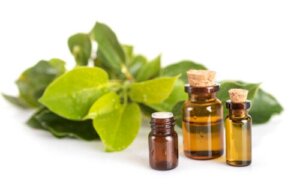Ravintsara Essential Oil: What Are Its Benefits?


Reviewed and approved by the pharmacist Franciele Rohor de Souza
Ravintsara essential oil is a product obtained from the Madagascar camphor tree (Cinnamomum camphora chemotype cineol). It’s estimated that it was first extracted in 1775 by the chemist and pharmacist Antoine Baumé. However, its medicinal properties only began to be evaluated in the last century.
Today, it’s valued for its soothing, antioxidant, anti-inflammatory, and antiviral properties. A study reported in the journal Molecules details that it has cosmetic, industrial, and pharmaceutical applications. In addition, it has traditionally been used for spiritual and religious purposes. Do you want to know more about it?
Uses and benefits of ravintsara essential oil
Contrary to what many think, ravintsara (Cinnamomum camphora chemotype cineole) isn’t native to the island of Madagascar. In fact, this camphor tree – a member of the Lauraceae family – actually comes from Asia, from countries such as India, China, and South Korea.
However, historical data indicate that it was introduced in Madagascar in the 17th century. Since then, its cultivation spread and became popular to the point of being known as the “Madagascar camphor tree.” The essential oil of this tree is obtained largely from its leaves through a steam current entrainment process.
Its main components are 1,8 cineol, alpha-pinene, and alpha-terpinene, which give it antiseptic, antiviral, and antioxidant qualities. Due to its multiple uses in alternative medicine, some call it “the oil that cures everything.”
However, is it as effective as they say? Let’s take a closer look at its potential benefits.
We think you may be interested in reading this, too: Mandelic Acid: What Is It and What Are its Benefits for the Skin?
An adjuvant against infections
One of the main benefits of ravintsara essential oil has to do with its antiviral potential. In particular, it’s used as an adjuvant to reduce the symptoms of the flu, colds, and other viral infections affecting the upper respiratory tract.
However, clinical evidence of these effects is lacking.
Even so, a study in the journal Molecules details that it has antimicrobial and antifungal qualities that could be useful against skin and lung infections. Specifically, it was determined that it acts effectively against the bacteria Serratia marcescens and the fungi Aspergillus niger and Aspergillus fumigatus.

It may help decrease pain and inflammation
In traditional medicine, this variety of essential oil is used as a remedy for muscle pain, migraine, and neuropathic pain, among others. The reason? Its volatile compounds relax the nervous system and produce a feeling of relief. In addition, it’s anti-inflammatory.
An animal study reported in the Indian Journal of Pharmaceutical Sciences evaluated the potential of this oil to combat migraine. The result showed that the constituents help inhibit nitric oxide production and the neurogenic inflammatory response involved in this ailment.
Meanwhile, research shared in the Journal of Ethnopharmacology supports its anti-inflammatory effects. One of its active compounds, borneol, is behind this property.
It’s believed to have the potential to soothe inflammatory skin diseases. However, more studies are needed to corroborate this.
Stress relief and memory stimulation
In aromatherapy, ravintsara essential oil is used to relax the nervous system and decrease symptoms of stress. In fact, anecdotal evidence associates its use with the stimulation of concentration and memory. However, there’s no scientific evidence to prove it.
An insecticide
One of the most prominent domestic uses of this essential oil is as an insecticide. Traditionally, it has been used to repel common household insects such as fleas, ants, and mites.
In addition, a study in the International Journal of Molecular Sciences reported that the compounds in this oil are a natural resource for managing insects, such as the red flour beetle (Tribolium castaneum Herbst) and the cigarette beetle (Lasioderma serricorne Fabricius), also present in commercial products.
Safety and precautions when using ravintsara essential oil
Ravintsara essential oil should only be used externally, either by diffuser or topically, in combination with a carrier oil. Its ingestion can be toxic. Symptoms of poisoning range from dizziness and nausea to headaches, confusion, and irritability.
It’s generally considered safe for most people. However, it should be avoided in the following cases:
- Children under two years of age
- On open wounds
- People with liver diseases
- Pregnant or breastfeeding women
- Patients with diseases such as Parkinson’s or epilepsy

How is ravintsara essential oil used?
This oil is generally used in aromatherapy in an aroma diffuser. 15 to 20 drops of the product are applied, either alone or in combination with citrus oils, such as lemon, grapefruit, or orange. Ideally, the aroma should be diffused for about 30 minutes. This is useful for calming respiratory symptoms and stress. However, for topical use, it should be combined with a carrier oil (such as coconut, lavender, almond, or olive oil).
Specifically, four drops of oil are added to a tablespoon (15 ml) of the chosen carrier oil. This is usually applied to areas such as the neck, wrists, and chest. It can be used 2 or 3 times a day. For cases of insomnia, stress, anxiety, or any emotional turmoil, it can be combined with lavender oil plus a carrier oil. The key is to add proportions of 5 drops of each essential oil for every 15 milliliters of carrier oil.
If your objective is to reduce muscular or joint ailments, just add five drops of the product in a spoonful of arnica oil. This can then be applied by massaging the desired areas.
Like this article? You may also like to read: 5 Tips to Protect the Skin Against the Effects of Air Conditioning
What to remember about this oil
Ravintsara essential oil is used in traditional medicine for its immunomodulatory, antioxidant, antiviral, and analgesic qualities. It’s often an adjunct against respiratory and skin infections. It also helps to relieve muscular ailments.
However, evidence of its properties is still limited. For now, studies have been done mainly in vitro and in animals. Therefore, a prudent use as a remedy for external use is suggested. It also shouldn’t be consumed because it’s toxic.
All cited sources were thoroughly reviewed by our team to ensure their quality, reliability, currency, and validity. The bibliography of this article was considered reliable and of academic or scientific accuracy.
- Lee SH, Kim DS, Park SH, Park H. Phytochemistry and Applications of Cinnamomum camphora Essential Oils. Molecules. 2022 Apr 22;27(9):2695. doi: 10.3390/molecules27092695. PMID: 35566046; PMCID: PMC9102863.
-
Shi, S., Wu, Q., Su, J., Li, C., Zhao, X., Xie, J., Gui, S., Su, Z., & Zeng, H. (2013). Composition analysis of volatile oils from flowers, leaves and branches ofCinnamomum camphorachvar.Borneolin china. In Journal of Essential Oil Research (Vol. 25, Issue 5, pp. 395–401). Informa UK Limited. https://doi.org/10.1080/10412905.2013.809323
- Poudel DK, Rokaya A, Ojha PK, Timsina S, Satyal R, Dosoky NS, Satyal P, Setzer WN. The Chemical Profiling of Essential Oils from Different Tissues of Cinnamomum camphora L. and Their Antimicrobial Activities. Molecules. 2021 Aug 24;26(17):5132. doi: 10.3390/molecules26175132. PMID: 34500567; PMCID: PMC8434199.
- FAN, L. & LIN, Q. & YANG, N. & CHEN, L.. (2020). Analgesic Effects of the Essential Oil from Cinnamomum camphora Against Nitroglycerin-induced Migraine in Mice. Indian Journal of Pharmaceutical Sciences. 82. 10.36468/pharmaceutical-sciences.634.
- Xiao, S., Yu, H., Xie, Y., Guo, Y., Fan, J., & Yao, W. (2021). The anti-inflammatory potential of Cinnamomum camphora (L.) J.Presl essential oil in vitro and in vivo. In Journal of Ethnopharmacology (Vol. 267, p. 113516). Elsevier BV. https://doi.org/10.1016/j.jep.2020.113516
- Jeannot, V., Roger, B., Chahboun, J., & Baret, P. (2007). Ravintsara (Cinnamomum camphora (L.) Presl.) essential oil and hydrolat in therapeutics. International Journal of Essential Oil Therapeutics, 1(1), 35–38.
- Guo S, Geng Z, Zhang W, Liang J, Wang C, Deng Z, Du S. The Chemical Composition of Essential Oils from Cinnamomum camphora and Their Insecticidal Activity against the Stored Product Pests. Int J Mol Sci. 2016 Nov 4;17(11):1836. doi: 10.3390/ijms17111836. PMID: 27827929; PMCID: PMC5133837.
- Xiao S, Yu H, Xie Y, Guo Y, Fan J, Yao W. Evaluation of the analgesic potential and safety of Cinnamomum camphora chvar. Borneol essential oil. Bioengineered. 2021 Dec;12(2):9860-9871. doi: 10.1080/21655979.2021.1996149. PMID: 34699310; PMCID: PMC8810075.
This text is provided for informational purposes only and does not replace consultation with a professional. If in doubt, consult your specialist.








